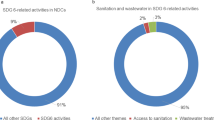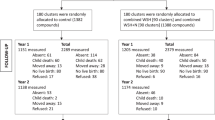Abstract
Despite China’s rapid progress in improving water, sanitation and hygiene (WSH) access, in 2011, 471 million people lacked access to improved sanitation and 401 million to household piped water. As certain infectious diseases are sensitive to changes in both climate and WSH conditions, we projected impacts of climate change on WSH-attributable diseases in China in 2020 and 2030 by coupling estimates of the temperature sensitivity of diarrhoeal diseases and three vector-borne diseases, temperature projections from global climate models, WSH-infrastructure development scenarios, and projected demographic changes. By 2030, climate change is projected to delay China’s rapid progress towards reducing WSH-attributable infectious disease burden by 8–85 months. This development delay summarizes the adverse impact of climate change on WSH-attributable infectious diseases in China, and can be used in other settings where a significant health burden may accompany future changes in climate even as the total burden of disease falls owing to non-climate reasons.
This is a preview of subscription content, access via your institution
Access options
Subscribe to this journal
Receive 12 print issues and online access
$209.00 per year
only $17.42 per issue
Buy this article
- Purchase on Springer Link
- Instant access to full article PDF
Prices may be subject to local taxes which are calculated during checkout



Similar content being viewed by others
References
Lim, S. S. et al. A comparative risk assessment of burden of disease and injury attributable to 67 risk factors and risk factor clusters in 21 regions, 1990–2010: A systematic analysis for the Global Burden of Disease Study 2010. Lancet 380, 2224–2260 (2012).
Prüss-Üstün, A. & Corvalan, C. How much disease burden can be prevented by environmental interventions? Epidemiology 18, 167–178 (2007).
Prüss, A., Kay, D., Fewtrell, L. & Bartram, J. Estimating the burden of disease from water, sanitation, and hygiene at a global level. Environ. Health Perspect. 110, 537–542 (2002).
Fewtrell, L., Prüss-Üstün, A., Bos, R., Gore, F. & Bartram, J. Water, Sanitation and Hygiene: Quantifying the Health Impact at National and Local Levels in Countries with Incomplete Water Supply and Sanitation Coverage (World Health Organization, 2007).
Prüss-Üstün, A., Bos, R., Gore, F. & Bartram, J. Safer Water, Better Health: Costs, Benefits and Sustainability of Interventions to Protect and Promote Health (World Health Organization, 2008).
Carlton, E. J. et al. Regional disparities in the burden of disease attributable to unsafe water and poor sanitation in China. Bull. World Health Organ. 90, 578–587 (2012).
Schaible, U. E. & Kaufmann, S. H. Malnutrition and infection: Complex mechanisms and global impacts. PLoS Med. 4, e115 (2007).
Bartram, J. & Cairncross, S. Hygiene, sanitation, and water: Forgotten foundations of health. PLoS Med. 7, e1000367 (2010).
Zhang, Y., Bi, P. & Hiller, J. E. Meteorological variables and malaria in a Chinese temperate city: A twenty-year time-series data analysis. Environ. Int. 36, 439–445 (2010).
Checkley, W. et al. Effects of El Nino and ambient temperature on hospital admissions for diarrhoeal diseases in Peruvian children. Lancet 355, 442–450 (2000).
Hashizume, M., Dewan, A. M., Sunahara, T., Rahman, M. Z. & Yamamoto, T. Hydroclimatological variability and dengue transmission in Dhaka, Bangladesh: A time-series study. BMC Infect. Dis. 12, 98 (2012).
Cann, K. F., Thomas, D. R., Salmon, R. L., Wyn-Jones, A. P. & Kay, D. Extreme water-related weather events and waterborne disease. Epidemiol. Infect. 141, 671–686 (2013).
Hales, S., de Wet, N., Maindonald, J. & Woodward, A. Potential effect of population and climate changes on global distribution of dengue fever: An empirical model. Lancet 360, 830–834 (2002).
Altizer, S., Ostfeld, R. S., Johnson, P. T., Kutz, S. & Harvell, C. D. Climate change and infectious diseases: From evidence to a predictive framework. Science 341, 514–519 (2013).
Wetherald, R. T. & Manabe, S. Simulation of hydrologic changes associated with global warming. J. Geophys. Res. 107, http://dx.doi.org/10.1029/2001jd001195 (2002).
Meehl, G. A. et al. in IPCC Climate Change 2007: The Physical Science Basis 747–845 (Cambridge Univ. Press, 2007).
World Health Organization & Department for International Development, Summary and Policy Implications Vision 2030: The Resilience of Water Supply and Sanitation in the Face of Climate Change (World Health Organization, 2009).
Curriero, F. C., Patz, J., Rose, J. B. & Lele, S. The association between extreme precipitation and waterborne disease outbreaks in the United States, 1948–1994. Am. J. Public Health 91, 1194–1199 (2001).
Burr, M. L., Davis, A. R. & Zbijowski, A. G. Diarrhoea and the drought. Public Health 92, 86–87 (1978).
Fewtrell, L. & Colford, J. M. Water, Sanitation and Hygiene: Interventions and Diarrhoea (World Bank, 2004).
Zhang, J. et al. Environmental health in China: Progress towards clean air and safe water. Lancet 375, 1110–1119 (2010).
The Millennium Development Goals Report (United Nations, 2013)
The Little Green Data Book 2010 (The World Bank, 2010)
Remais, J. V. & Zhang, J. Environmental lessons from China: Finding promising policies in unlikely places. Environ. Health Perspect. 119, 893–895 (2011).
IPCC Climate Change 2013: The Physical Science Basis (eds Stocker, T. F. et al.) (Cambridge Univ. Press, 2013).
Chen, L. & Frauenfeld, O. W. Surface air temperature changes over the twentieth and twenty-first centuries in China simulated by 20 CMIP5 models. J. Clim. 27, 3920–3937 (2014).
WHO/UNICEF Joint Monitoring Program, China: Estimates on the Use of Water Sources and Sanitation Facilities (1980–2012) (World Health Organization, 2014).
Van Vuuren, D. P. et al. The representative concentration pathways: An overview. Climatic Change 109, 5–31 (2011).
Cook, I. G. & Dummer, T. J. Changing health in China: Re-evaluating the epidemiological transition model. Health Policy 67, 329–343 (2004).
Gong, P. et al. Urbanisation and health in China. Lancet 379, 843–852 (2012).
Martin, G. M. et al. The HadGEM2 family of Met Office Unified Model climate configurations. Geosci. Model Dev. 4, 723–757 (2011).
Jones, G. W. Southeast Asian urbanization and the growth of mega-urban regions. J. Popul. Res. 19, 119–136 (2002).
Kolstad, E. W. & Johansson, K. A. Uncertainties associated with quantifying climate change impacts on human health: A case study for diarrhea. Environ. Health Perspect. 119, 299–305 (2011).
Chang, C-C. A multivariate causality test of carbon dioxide emissions, energy consumption and economic growth in China. Appl. Energy 87, 3533–3537 (2010).
Policy Note: Concessionary Financing Programs for the Water and Sanitation Sector Report No. 56105 (The World Bank, 2009)
Hutton, G., Rodriguez, U. E., Naptitupulu, L., Thang, P. & Kov, P. Economic Impacts of Sanitation in South Asia (World Bank, 2008).
McMichael, A. J. et al. in Comparative Quantification of Health Risks: Global and Regional Burden of Disease Attributable to Selected Major Risk Factors Vol. 1 (eds Ezzati, M., Lopez, A. D., Rodgers, A. & Murray, C. J. L.) Ch. 20, 1543–1649 (World Health Organization, 2004).
Campbell-Lendrum, D. & Woodruff, R. Comparative risk assessment of the burden of disease from climate change. Environ. Health Perspect. 114, 1935–1941 (2006).
CIESIN & CIAT Gridded Population of the World (CIESIN, 2011).
Landoni, M. Two Scenarios on Chinese Population Dynamics Based on a Multiregional Projection Model (Duke Univ., 2006).
Toth, F., Cao, G. & Hizynyik, E. Regional Population Projections for China Report No. IR-03-042 (International Institute for Applied Systems Analysis, 2003)
Collins, W. J. et al. Development and evaluation of an Earth-System model HadGEM2. Geosci. Model Dev. 4, 1051–1075 (2011).
Taylor, K. E., Stouffer, R. J. & Meehl, G. A. An overview of CMIP5 and the experiment design. Bull. Am. Meteorol. Soc. 93, 485–498 (2012).
Borenstein, M., Hedges, L. V., Higgins, J. P. T. & Rothstein, H. R. A basic introduction to fixed-effect and random effects models for meta-analysis. Res. Synth. Methods 1, 97–111 (2010).
Murray, C. L. J. & Lopez, A. D. The Global Burden of Disease: A Comprehensive Assessment of Mortality and Disability from Diseases, Injuries, and Risk Factors in 1990 and Projected to 2020 (Harvard Univ. Press, 1996).
Acknowledgements
This work was supported in part by the Chemical, Bioengineering, Environmental, and Transport Systems Division of the National Science Foundation under grant no. 1249250, by the Division of Earth Sciences of the National Science Foundation under grant no. 1360330, by the National Institute for Allergy and Infectious Disease (K01AI091864) and by the Global Health Institute at Emory University. Y.L. was supported in part by the Centers for Disease Control and Prevention (U01EH000405) and the National Institutes of Health (R21ES020225). S.L. was supported in part by US EPA Science to Achieve Results grant (RD835192010) and by Emerging Pathogens Institute, University of Florida. Y.G. was supported in part by the Office of Science of the U.S. Department of Energy as part of the Regional and Global Climate Modeling Program. The Pacific Northwest National Laboratory is operated for DOE by Battelle Memorial Institute (DE-AC05-76RL01830).
Author information
Authors and Affiliations
Contributions
M.H., J.H.B., E.J.C., S.L., H.L., W.L., J.J.H. and J.V.R. conceived and designed the experiments; M.H., J.H.B., S.L., Y.G. and J.V.R. performed the experiments; M.H., J.H.B., Y.G. and J.V.R. analysed the data; M.H., J.H.B., E.J.C., S.L., H.L., W.L., M.C.F., Y.L., J.J.H. and J.V.R. contributed materials/analysis tools; and M.H., J.H.B., E.J.C., S.L., H.L., W.L., M.C.F., Y.L., Y.G., J.J.H. and J.V.R. wrote the paper.
Corresponding author
Ethics declarations
Competing interests
The authors declare no competing financial interests.
Supplementary information
Rights and permissions
About this article
Cite this article
Hodges, M., Belle, J., Carlton, E. et al. Delays in reducing waterborne and water-related infectious diseases in China under climate change. Nature Clim Change 4, 1109–1115 (2014). https://doi.org/10.1038/nclimate2428
Received:
Accepted:
Published:
Issue Date:
DOI: https://doi.org/10.1038/nclimate2428
This article is cited by
-
The impact of extreme weather events on water quality: international evidence
Natural Hazards (2023)
-
Climate Change Impacts on Waterborne Diseases: Moving Toward Designing Interventions
Current Environmental Health Reports (2018)
-
Post-earthquake Zika virus surge: Disaster and public health threat amid climatic conduciveness
Scientific Reports (2017)
-
Surveillance systems for neglected tropical diseases: global lessons from China’s evolving schistosomiasis reporting systems, 1949–2014
Emerging Themes in Epidemiology (2014)



